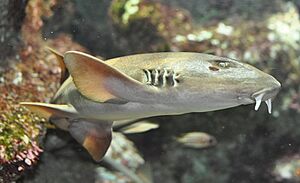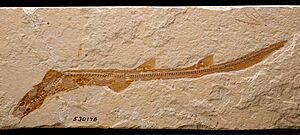Hemiscylliidae facts for kids
Quick facts for kids Hemiscylliidae |
|
|---|---|
 |
|
| Grey bamboo shark (Chiloscyllium griseum) | |
| Scientific classification |
|
| Kingdom: | Animalia |
| Phylum: | Chordata |
| Class: | Chondrichthyes |
| Order: | Orectolobiformes |
| Family: | Hemiscylliidae T. N. Gill, 1862 |
The Hemiscylliidae are a fascinating group of sharks, often called longtail carpet sharks or bamboo sharks. They belong to the order Orectolobiformes, which includes other bottom-dwelling sharks. These sharks live in the warm, shallow waters of the Indo-Pacific Ocean. This area stretches from the Indian Ocean to the western Pacific. They are known for their unique appearance and calm nature.
These sharks are relatively small. The biggest species grows to about 121 centimeters (48 inches) long. They have long, round bodies, like a cylinder. You can spot them by their short barbels, which are whisker-like feelers near their mouths. They also have large spiracles, which are breathing holes located behind their eyes. As their common name suggests, their tails are unusually long. In fact, their tails are longer than the rest of their bodies! These sharks are slow-moving and prefer to stay near the ocean floor. They mostly eat small creatures that live on the bottom, such as invertebrates and tiny fish. Bamboo sharks can make interesting sounds. They might make popping and sucking noises when they eat. If they feel stressed, they might click their jaws. They can also hiss by pushing water out of their gills.
Contents
Discovering Longtail Carpet Sharks
There are two main groups, or genera, of longtail carpet sharks: Chiloscyllium and Hemiscyllium. Each group has several different species. These species have unique features that help scientists tell them apart.
The Chiloscyllium Sharks
Sharks in the Chiloscyllium group are known for their relatively long snouts. Their nostrils are located a bit underneath the snout tip. Their eyes and the ridges above them are not very raised. The mouth of these sharks is closer to their eyes than to the tip of their snout. They often have a flap of skin connecting the lower lip folds across their chin. Their pectoral (side) and pelvic fins (bottom) are usually thin and not very muscular. These sharks typically do not have a large black hood on their head or a big black spot on their side. However, young Chiloscyllium sharks often have strong dark spots or stripes.
Some examples of Chiloscyllium sharks include:
- Chiloscyllium arabicum (Arabian carpetshark)
- Chiloscyllium burmensis (Burmese bamboo shark)
- Chiloscyllium caeruleopunctatum (Blue-spotted bamboo shark)
- Chiloscyllium griseum (Grey bamboo shark)
- Chiloscyllium hasselti (Hasselt's bamboo shark)
- Chiloscyllium indicum (Slender bamboo shark)
- Chiloscyllium plagiosum (White-spotted bamboo shark)
- Chiloscyllium punctatum (Brown-banded bamboo shark)
The Hemiscyllium Sharks
Sharks in the Hemiscyllium group are found in tropical waters around Australia, Papua New Guinea, and Indonesia. There was even a sighting of one, possibly a new species, near the Seychelles. These sharks have shorter snouts. Their nostrils are placed almost at the very tip of the snout. Their eyes and the ridges above them are quite raised. Their mouth is closer to the tip of the snout than to their eyes. Unlike Chiloscyllium sharks, they do not have a connecting skin fold across their chin. Their pectoral and pelvic fins are thick and very muscular. A key feature of Hemiscyllium sharks is that they usually have either a black hood on their head or a large black spot on the sides of their body. The Epaulette shark is a well-known example from this group.
There are nine recognized species in this genus, including:
- Hemiscyllium freycineti (Indonesian speckled carpetshark)
- Hemiscyllium galei (Cenderwasih epaulette shark)
- Hemiscyllium hallstromi (Papuan epaulette shark)
- Hemiscyllium halmahera (Halmahera epaulette shark)
- Hemiscyllium henryi (Henry's epaulette shark)
- Hemiscyllium michaeli (Milne Bay epaulette shark)
- Hemiscyllium ocellatum (Epaulette shark)
- Hemiscyllium strahani (Hooded carpetshark)
- Hemiscyllium trispeculare (Speckled carpetshark)
Ancient Relatives: Sharks from the Past
The family Hemiscylliidae has a long history. Scientists have found fossils of these sharks that date back to the Upper Jurassic period. This means their ancestors swam in the oceans millions of years ago! Studying these fossils helps us understand how these amazing sharks have changed over time. Some of these ancient relatives include species like Acanthoscyllium sahelalmae and Hemiscyllium bruxelliensis.
Living with Sharks: In Aquariums
Longtail carpet sharks are sometimes kept in home aquariums. They are considered good aquarium sharks for a few reasons. Their natural homes are often tide pools, coral beds, and rocky areas. These are relatively small and confined spaces. This helps them adapt better to living in an aquarium compared to some other shark species. They are also generally small for sharks. Plus, they prefer water temperatures similar to those enjoyed by many other common aquarium fish. This makes them popular with people who keep marine aquariums. Many species of these sharks have even successfully had babies while living in captivity.
If you were to keep an epaulette shark, a full-grown adult would need a tank of at least 680 liters (180 US gallons). Bamboo sharks need even more space, doing well in aquariums around 900 liters (240 US gallons). It is important to provide artificial caves for these sharks to hide in. However, tank decorations must be very stable. These sharks like to dig, and unstable structures could fall and cause serious injury.
A Special Way to Reproduce
In a very rare event, a bamboo shark at Great Yarmouth’s Sea Life Centre in the United Kingdom became pregnant with two fertilized eggs. This happened even though the shark had not been with any other bamboo sharks since 2013. This amazing event is an example of something called parthenogenesis. Parthenogenesis is a special and rare way some animals can have babies without a male partner. It was such an unusual occurrence for this type of shark that it became a news story on February 10, 2016.


